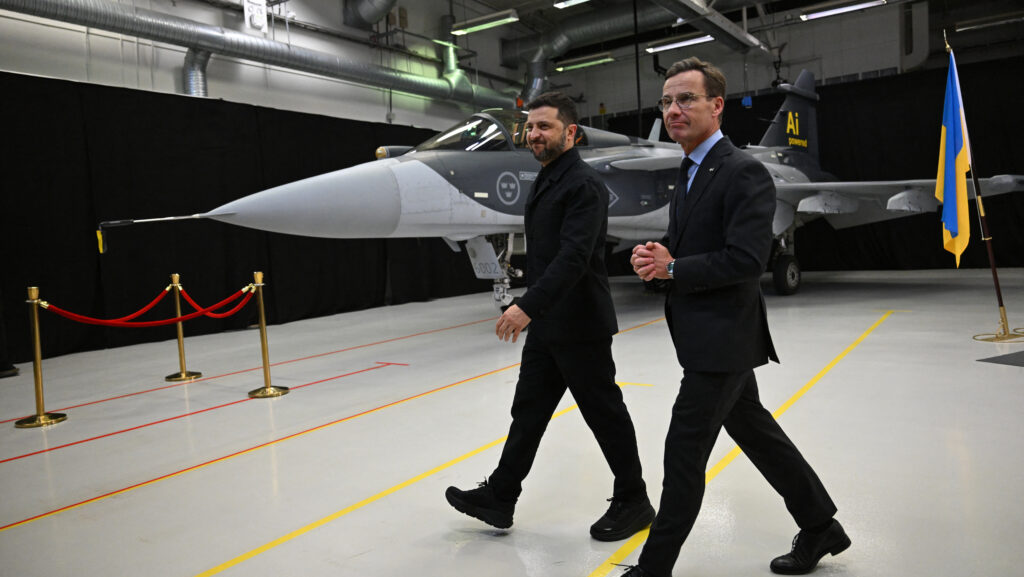COPENHAGEN — Ukraine’s President Volodymyr Zelenskyy and Sweden’s Prime Minister Ulf Kristersson today signed a letter of intent laying the groundwork for Kyiv to make a massive purchase of anywhere from 100 to 150 Gripen E fighter jets from Swedish defense firm Saab.
The agreement, announced during a press conference at Saab’s factory in Linköping, marks the start of a long-term industrial partnership between Sweden and Ukraine, with a focus on air defense. “This is the beginning of a long journey, but it takes us one step closer to a major export deal for Saab and Sweden and Ukraine,” Kristersson said.
Sweden has already delivered extensive military aid to Ukraine, including armored vehicles, artillery, air defense, and the ASC 890 radar reconnaissance aircraft, internationally known as Saab Erieye, the older version of Saab GlobalEye. These planes enhance the capabilities of the donated F-16s currently in use in the war.
However, today’s agreement is not about urgent donations. Instead, it points toward a longer-term “major defense industrial deal” involving the Gripen E, the latest model recently introduced into the Swedish Air Force. Ukraine would then join a “growing family” of users of this unique, flexible air power system, Kristersson said.
“It is a clear and mutual statement of intent — the beginning of a journey over 10-15 years,” the prime minister emphasized. Production of the Gripen E is now ramping up, with first deliveries to Ukraine possible in about three years. Deliveries would occur gradually over a long period, given the enormous sums involved.
The parties are now launching work together with other partners to explore financing options for Ukraine’s broader defense.
“A strong Ukraine with a strong defense is the best long-term protection – not just for Ukraine, but for all of Europe. Control of airspace is crucial,” Kristersson said.
A next step could be taken as early as Thursday, when the European Council in Brussels discusses frozen Russian assets. Both leaders are flying there late today. Even after the war, long-term financing will be needed for reconstruction and defense — a prerequisite for the deal. Sweden also emphasizes mutual benefits: “We learn a lot from Ukraine”.
The question of immediate Gripen deliveries from Swedish surplus hangs in the air. “We have not ruled out the possibility of Gripen here and now, planes not used by Sweden,” Kristersson said in response to a direct question. But the decision from the airborne radar surveillance system ASC 890 delivery stands: they provide the best command capability for Ukraine’s F-16s right now, instead of introducing small-scale systems, Kristerson said.
“That assessment can change, but right now we are focused on the radar reconnaissance aircraft. First, we jointly investigate financing options.”
The prime minister was clear that nothing is finalized. “This is a very clear political and industrial statement of intent. This is how the first major projects truly begins.”
For his part, Zelenskyy indicated Ukraine was hoping to see some Gripens as early as next year.
The Ukrainian leader said on X, “We consider the JAS 39 Gripen aircraft to be one of the most effective elements of this effort and count on the first deliveries of Gripens already in 2026.”
Ukrainian pilots have been in Sweden to test the Gripen. The jets represent a new-generation upgrade with a range of higher-end capabilities, including electronic warfare, a more powerful engine, and increased weapons capacity.
For the last year, supplying Gripen jets to Ukraine has been under consideration but was paused to let Kyiv prioritize integrating US-made F-16 fighters, which it began deploying last summer.
The deal, should it proceed as planned, promises huge opportunities for Ukraine’s air force, Swedish defense industry, and a stronger Europe against Russia’s aggression. “The free world must increase political and economic pressure on Putin to stop this brutal war,” the prime minister concluded.
Sweden’s military aid to Ukraine has reached 90 billion kronor ($8.44 billion) since the 2022 invasion. Just a month ago the government proposed in the 2026 budget bill an additional 31.5 billion kronor, raising the framework to 40 billion kronor per year for both 2026 and 2027 – for continued robust support, as a government fact sheet in September.

